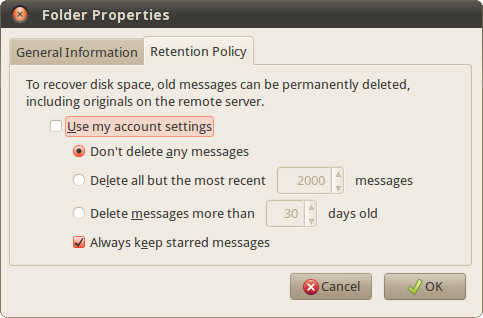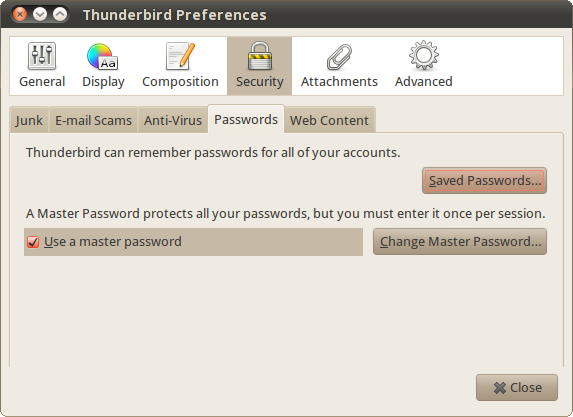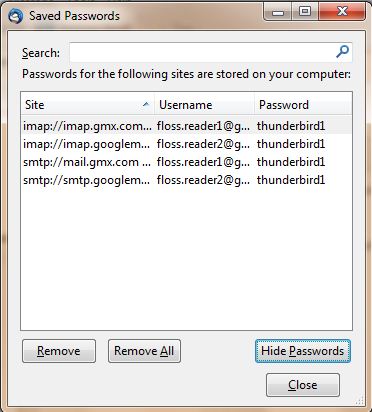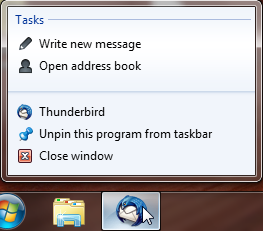Useful Tips and Tricks
This chapter covers some tips and tricks that can make your use of Thunderbird easier, more enjoyable, and more efficient.
Backing Up Your Profile
Your profile is a collection of information about how you use and have set up Thunderbird. The profile contains:
- Your local email messages and any copies of email messages from a mail server.
- Your email account settings and any changes that you have made to Thunderbird, like customizations to the tool bar.
It's a good idea to back up your profile. Why? If Thunderbird crashes, the crash can corrupt your profile and make it unusable. If your computer crashes, it can take your Thunderbird settings with it. And if you're moving to a new computer, copying your profile over is faster and easier than manually setting up Thunderbird again.
Note that your profile may be quite large, especially if you have a lot of email messages. It's possible to have a profile that contains several gigabytes of email data. If your profile is that big, you should be careful about where you copy and store it. While today's hard drives are quite large, if you save multiple copies of your profile you may fill up your drive with Thunderbird profiles.
Backing up your profile involves two steps: finding your profile and copying it somewhere else. Here's how to do both.
Finding Your Thunderbird Profile
Your profile is stored in your computer's user or home directory. Let's take a look at finding it on Windows, Mac OS X, and Linux.
To find your profile in Windows:
- From the Start menu, choose Run. The Run window appears.
- Type %APPDATA%\Thunderbird\Profiles\ in the Run window and then press Enter on your keyboard. The folder containing your Thunderbird profile opens in Windows Explorer.
Your profile folder will have a name like xxxxxxxx.default, where xxxxxxxx is a set of random characters like q4sl99rt.
To find your profile in Mac OS:
- Open Finder and go to your home folder.
-
From your home folder open the folder at Library:Thunderbird:Profile.
To find your profile in Linux:
- Open your file manager. For example, in Linux distributions running the GNOME desktop (like Ubuntu) start Nautilus.
- Change the view settings of your file manager to show hidden files. In Ubuntu, for example, press CTRL + H on your keyboard.
- Open the folder named .thunderbird. Your profile folder will have a name like xxxxxxxx.default, where xxxxxxxx is a set of random characters like q4sl99rt.
Doing the backup
Here's how to backup your profile.
- Shut down Thunderbird.
- Go to your Thunderbird profile directory, and then do one of the following:
- Right click on the profile directory, and then select Copy from the menu that appears. Go to the directory where you want to back up the profile, right click in that directory, and select Paste from the menu that appears.
- Compress your profile directory into a zip file. From there, you can move the zip file into another directory on your computer, to another computer, or to an online backup service.
When you need to restore the your profile, just move the files that you backed up into your profile directory.
For Windows users only
There is a free program called MozBackUp which will back up your Thunderbird or Firefox profile for you. It has a wizard that steps you through the process of backing up and restoring bookmarks, mail, contacts, history, extensions, passwords, cache, and other Mozilla user or configuration data.
MozillaZine articles about profile back ups
Automatically Delete Emails
If you actually do want to automatically delete old messages, you don't have to do that manually. Instead, you can set a message retention policy to automatically delete messages. A message retention policy will delete email messages in a folder after a certain time. You can set a retention policy for individual mail folders.
Here's how to do it.
To set up a message retention policy
- Right click on the email folder for which you want to set up a retention property, and then click Properties from the menu that appears.
- The Folder Properties window opens.
- Click the Retention Policy tab.

- Click the Use my account settings option to turn it off.
- Do one of the following:
- Select the Delete all but the most recent messages option, and then enter the number of recent messages that you want to keep.
- Select the Delete messages more than days old option, then enter the number of days you want to keep the messages.
- Click the OK button.
From now on, Thunderbird will delete messages in that folder based on the retention policy you create.
Recovering Your Passwords
Chances are that you have more than just a couple of passwords for things like online banking, your favorite social media sites, and (of course) your email accounts. When you set up your email accounts in Thunderbird, you probably set it up to remember passwords for those accounts.
If you've forgotten those passwords, it's not a problem because you can retrieve those passwords from Thunderbird. Here's how:
- Open the Preferences/Options dialog box:
- In Windows and Mac OS, go to the Tools menu and click Options.
- In Linux, go to the Edit menu and click Preferences.
- Click Security and then click the Passwords tab.

- On the Passwords tab, click the Saved Passwords button. The Saved Passwords window displays.
- On the Saved Passwords window, click the Show Passwords button. You'll be asked whether you really want to show your passwords. Click Yes.

- Note down or remember the password for the account in question, then click the Close button.
Support for Windows 7 Jump Lists
In Windows 7, the Jump Lists function lets you quickly open the files or functions you use the most . By right-clicking on a program icon in the taskbar, a small window opens with a list of recent and frequently accessed files and tasks.
For Thunderbird, the Jump List function shows two common tasks: write new message and open address book.






